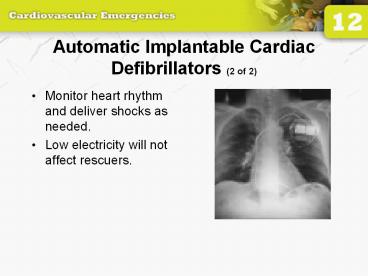Automatic Implantable Cardiac Defibrillators (2 of 2) - PowerPoint PPT Presentation
1 / 22
Title:
Automatic Implantable Cardiac Defibrillators (2 of 2)
Description:
Cardiac Arrest During Transport (2 of 2) If patient becomes unconscious during transport: Check pulse. Stop the vehicle. Perform CPR until AED is available. – PowerPoint PPT presentation
Number of Views:96
Avg rating:3.0/5.0
Title: Automatic Implantable Cardiac Defibrillators (2 of 2)
1
Automatic Implantable Cardiac Defibrillators (2
of 2)
- Monitor heart rhythm and deliver shocks as
needed. - Low electricity will not affect rescuers.
2
Cardiac Arrest
- The complete cessation of cardiac activity,
either electrical, mechanical, or both.
3
Automated External Defibrillator (AED)
- AEDs come in various models.
- Some operator interaction required.
- A specialized computer recognizes heart rhythms
that require defibrillation.
4
Potential AED Problems
- Battery is dead.
- Patient is moving.
- Patient is responsive and has a rapid pulse.
5
AED Advantages
- ALS providers do not need to be on scene.
- Remote, adhesive defibrillator pads are used.
- Efficient transmission of electricity
6
Non-Shockable Rhythms
- Asystole
- Pulseless electrical activity
7
Rationale for Early Defibrillation
- Early defibrillation is the third link in the
chain of survival. - A patient in ventricular fibrillation needs to be
defibrillated within 2 minutes.
8
AED Maintenance
- Read operators manual.
- Check AED and battery at beginning of each shift.
- Get a checklist from the manufacturer.
- Report any failures to the manufacturer and the
FDA.
9
Medical Direction
- Should approve protocols
- Should review AED usage
- Should review speed of defibrillation
- Should provide review of skills every 3 to 6
months
10
Preparation
- Make sure the electricity injures no one.
- Do not defibrillate a patient lying in pooled
water. - Dry a soaking wet patients chest first.
- Do not defibrillate a patient who is touching
metal. - Remove nitroglycerin patches.
- Shave a hairy patients chest if needed.
11
Using an AED (1 of 8)
- Assess responsiveness.
- Stop CPR if in progress.
- Check breathing and pulse.
- If patient is unresponsive and not breathing
adequately, give two slow ventilations.
12
Using an AED (2 of 8)
- If there is a delay in obtaining an AED, have
your partner start or resume CPR. - If an AED is close at hand, prepare the AED pads.
- Turn on the machine.
13
Using an AED (3 of 8)
- Remove clothing from the patients chest area.
Apply pads to the chest. - Stop CPR.
- State aloud, Clear the patient.
14
Using an AED (4 of 8)
- Push the analyze button, if there is one.
- Wait for the computer.
- If shock is not needed, start CPR.
- If shock is advised, make sure that no one is
touching the patient. - Push the shock button.
15
Using an AED (5 of 8)
- After the shock is delivered, most AEDs will
automatically reanalyze the rhythm if not, push
the analyze button again. - If the machine advises a shock, deliver a second
shock. - Reanalyze the rhythm.
- If the machine advises a shock, deliver a third
shock.
16
Using an AED (6 of 8)
- Check for pulse.
- If the patient has a pulse, check breathing.
- If the patient is breathing adequately, provide
oxygen via nonrebreathing mask and transport.
17
Using an AED (7 of 8)
- If the patient is not breathing adequately, use
necessary airway adjuncts and proper positioning
to open airway. - Provide artificial ventilations with
high-concentration oxygen. - Transport.
18
Using an AED (8 of 8)
- If the patient has no pulse, perform 1 minute of
CPR. - Gather additional information on the arrest
event. - After 1 minute of CPR, make sure no one is
touching the patient. - Push the analyze button again (as applicable).
- If necessary, repeat one cycle of up to three
stacked shocks. - Transport and check with medical control.
- Continue to support the patient as needed.
19
After AED Shocks
- Check pulse.
- No pulse, no shock advised
- No pulse, shock advised
- If a patient is breathing independently
- Administer oxygen.
- Check pulse.
- If a patient has a pulse but breathing is
inadequate, assist ventilations.
20
Transport Considerations
- Transport
- When patient regains pulse
- After delivering six to nine shocks
- After receiving three consecutive no shock
advised messages - Keep AED attached.
- Check pulse frequently.
- Stop ambulance to use an AED.
21
Cardiac Arrest During Transport (1 of 2)
- Check unconscious patients pulse every 30
seconds. - If pulse is not present
- Stop the vehicle.
- Perform CPR until AED is available.
- Analyze rhythm.
- Deliver shock(s).
- Continue resuscitation according to local
protocol.
22
Cardiac Arrest During Transport (2 of 2)
- If patient becomes unconscious during transport
- Check pulse.
- Stop the vehicle.
- Perform CPR until AED is available.
- Analyze rhythm.
- Deliver up to three shocks.
- Continue resuscitation according to local
protocol.































